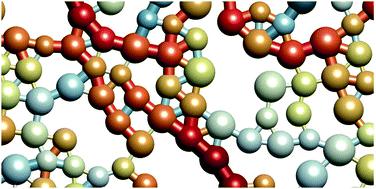当前位置:
X-MOL 学术
›
Soft Matter
›
论文详情
Our official English website, www.x-mol.net, welcomes your
feedback! (Note: you will need to create a separate account there.)
Viscosity of cohesive granular flows
Soft Matter ( IF 2.9 ) Pub Date : 2020-10-29 , DOI: 10.1039/d0sm01456g Matthew Macaulay 1, 2, 3, 4 , Pierre Rognon 1, 2, 3, 4
Soft Matter ( IF 2.9 ) Pub Date : 2020-10-29 , DOI: 10.1039/d0sm01456g Matthew Macaulay 1, 2, 3, 4 , Pierre Rognon 1, 2, 3, 4
Affiliation

|
Cohesive granular materials such as wet sand, snow, and powders can flow like a viscous liquid. However, the elementary mechanisms of momentum transport in such athermal particulate fluids are elusive. As a result, existing models for cohesive granular viscosity remain phenomenological and debated. Here we use discrete element simulations of plane shear flows to measure the viscosity of cohesive granular materials, while tuning the intensity of inter-particle adhesion. We establish that two adhesion-related, dimensionless numbers control their viscosity. These numbers compare the force and energy required to break a bond to the characteristic stress and kinetic energy in the flow. This progresses the commonly accepted view that only one dimensionless number could control the effect of adhesion. The resulting scaling law captures strong, non-Newtonian variations in viscosity, unifying several existing viscosity models. We then directly link these variations in viscosity to adhesion-induced modifications in the flow micro-structure and contact network. This analysis reveals the existence of two modes of momentum transport, involving either grain micro-acceleration or balanced contact forces, and shows that adhesion only affects the latter. This advances our understanding of rheological models for granular materials and other soft materials such as emulsions and suspensions, which may also involve inter-particle adhesive forces.
中文翻译:

粘性颗粒流的粘度
粘性粒状材料(例如湿沙,雪和粉末)会像粘性液体一样流动。然而,在这种非热颗粒流体中动量传输的基本机理是难以捉摸的。结果,粘聚颗粒粘度的现有模型仍然是现象学的,并且存在争议。在这里,我们使用平面剪切流的离散元素模拟来测量粘性粒状材料的粘度,同时调整粒子间粘附的强度。我们建立了两个与粘合有关的无因次数来控制其粘度。这些数字将打破键所需的力和能量与流中的特征应力和动能进行比较。这种观点得到了普遍接受的观点,即只有一个无量纲的数字可以控制粘合效果。由此产生的缩放定律捕获了强大的,非牛顿粘度变化,统一了几种现有的粘度模型。然后,我们将粘度的这些变化直接与流动微观结构和接触网络中粘附诱导的改性联系起来。该分析揭示了动量传输的两种模式的存在,涉及晶粒的微加速度或平衡的接触力,并且表明粘附仅影响后者。这使我们对粒状材料和其他软质材料(如乳液和悬浮液)的流变模型的理解更加深入,这些流变模型也可能涉及粒子间的粘附力。该分析揭示了动量传输的两种模式的存在,涉及晶粒的微加速度或平衡的接触力,并且表明粘附仅影响后者。这使我们对粒状材料和其他软质材料(如乳液和悬浮液)的流变模型的理解更加深入,这些流变模型也可能涉及粒子间的粘附力。该分析揭示了动量传输的两种模式的存在,涉及晶粒的微加速度或平衡的接触力,并且表明粘附仅影响后者。这使我们对粒状材料和其他软质材料(如乳液和悬浮液)的流变模型的理解更加深入,这些流变模型也可能涉及粒子间的粘附力。
更新日期:2020-11-09
中文翻译:

粘性颗粒流的粘度
粘性粒状材料(例如湿沙,雪和粉末)会像粘性液体一样流动。然而,在这种非热颗粒流体中动量传输的基本机理是难以捉摸的。结果,粘聚颗粒粘度的现有模型仍然是现象学的,并且存在争议。在这里,我们使用平面剪切流的离散元素模拟来测量粘性粒状材料的粘度,同时调整粒子间粘附的强度。我们建立了两个与粘合有关的无因次数来控制其粘度。这些数字将打破键所需的力和能量与流中的特征应力和动能进行比较。这种观点得到了普遍接受的观点,即只有一个无量纲的数字可以控制粘合效果。由此产生的缩放定律捕获了强大的,非牛顿粘度变化,统一了几种现有的粘度模型。然后,我们将粘度的这些变化直接与流动微观结构和接触网络中粘附诱导的改性联系起来。该分析揭示了动量传输的两种模式的存在,涉及晶粒的微加速度或平衡的接触力,并且表明粘附仅影响后者。这使我们对粒状材料和其他软质材料(如乳液和悬浮液)的流变模型的理解更加深入,这些流变模型也可能涉及粒子间的粘附力。该分析揭示了动量传输的两种模式的存在,涉及晶粒的微加速度或平衡的接触力,并且表明粘附仅影响后者。这使我们对粒状材料和其他软质材料(如乳液和悬浮液)的流变模型的理解更加深入,这些流变模型也可能涉及粒子间的粘附力。该分析揭示了动量传输的两种模式的存在,涉及晶粒的微加速度或平衡的接触力,并且表明粘附仅影响后者。这使我们对粒状材料和其他软质材料(如乳液和悬浮液)的流变模型的理解更加深入,这些流变模型也可能涉及粒子间的粘附力。











































 京公网安备 11010802027423号
京公网安备 11010802027423号